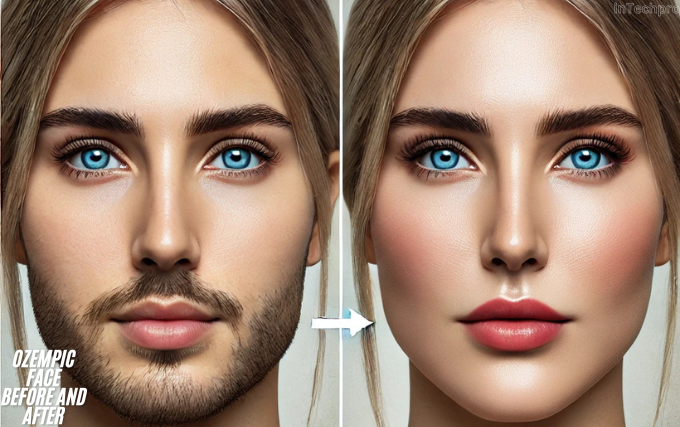Ozempic, a medication widely used for managing type 2 diabetes, has recently garnered attention for its potential impact on facial appearance. Commonly referred to as “Ozempic face,” this phenomenon involves noticeable changes in facial structure and skin quality, particularly for those experiencing significant weight loss while on the medication. This article delves into the before and after effects of Ozempic on the face, exploring the science behind these changes, real-life experiences, and strategies to manage them.
Understanding Ozempic
What is Ozempic?
Ozempic is the brand name for semaglutide, a glucagon-like peptide-1 (GLP-1) receptor agonist. It is primarily prescribed to help manage blood sugar levels in individuals with type 2 diabetes. By mimicking the action of the GLP-1 hormone, Ozempic helps stimulate insulin secretion, reduce glucagon release, and slow gastric emptying. These actions collectively contribute to better blood sugar control.
How Does Ozempic Work?
Ozempic works by activating GLP-1 receptors in the pancreas, which in turn increases insulin production when blood sugar levels are high. Additionally, it helps reduce the amount of sugar released by the liver and slows down the rate at which food leaves the stomach. This combination of effects helps lower blood glucose levels and supports weight loss, making it a dual-purpose treatment for diabetes and obesity.
The Phenomenon of “Ozempic Face”
What is “Ozempic Face”?
“Ozempic face” refers to the changes in facial appearance that some individuals experience after significant weight loss induced by Ozempic. These changes can include sagging skin, a gaunt or hollow look, and more pronounced wrinkles. While weight loss can positively impact overall health, the loss of facial fat can sometimes result in less desirable cosmetic effects.
Why Does Ozempic Cause Changes in Facial Appearance?
The primary reason for changes in facial appearance with Ozempic is weight loss. Facial fat plays a crucial role in maintaining a youthful and plump appearance. When individuals lose weight rapidly, the reduction in facial fat can lead to a more aged and tired look. Additionally, as skin loses its underlying support structure, it may sag or develop wrinkles.
Individual Experiences
The extent of changes in facial appearance varies from person to person. Some may notice only minor differences, while others may experience more significant changes. Factors such as age, skin elasticity, genetics, and the amount of weight lost all play a role in how one’s face may change with Ozempic use.
Before and After: Real-Life Experiences
Case Studies
Case Study 1: Sarah’s Journey
Before starting Ozempic, Sarah, a 45-year-old woman with type 2 diabetes, struggled with her weight for years. After six months on Ozempic, she lost 35 pounds. While thrilled with her weight loss and improved health, Sarah noticed her face looked different. Her cheeks appeared hollow, and she developed fine lines around her mouth and eyes.
Case Study 2: John’s Transformation
John, a 50-year-old man, started Ozempic to manage his diabetes and lose weight. Over a year, he lost 50 pounds. Though he felt healthier and more energetic, he observed that his face had lost some of its youthful fullness. His friends and family commented on his more aged appearance, even though his overall health had improved.
Testimonials from Online Communities
Many individuals have shared their experiences with “Ozempic face” on social media and online forums. Some report feeling self-conscious about their changed appearance, while others embrace their new look as a sign of their successful health journey. These testimonials highlight the varied emotional responses to the physical changes induced by Ozempic.
Managing Changes in Facial Appearance
Medical and Cosmetic Solutions
Dermatological Treatments
For those concerned about the cosmetic effects of “Ozempic face,” there are several dermatological treatments available. Dermal fillers can restore lost volume in the cheeks and under the eyes, helping to rejuvenate the face. Additionally, skin-tightening procedures, such as laser therapy or radiofrequency treatments, can improve skin elasticity and reduce sagging.
Skincare Regimens
Adopting a comprehensive skincare regimen can also help manage changes in facial appearance. Products containing retinoids, hyaluronic acid, and peptides can promote collagen production and improve skin texture. Regular moisturizing and sun protection are essential to maintain healthy skin.
Lifestyle Adjustments
Nutrition and Hydration
Maintaining a balanced diet rich in vitamins, minerals, and antioxidants supports overall skin health. Adequate hydration is also crucial for keeping skin plump and resilient. Incorporating foods high in omega-3 fatty acids, such as fish and flaxseeds, can help maintain skin elasticity.
Exercise and Facial Exercises
Regular exercise promotes blood circulation, which benefits the skin. Additionally, facial exercises, also known as “face yoga,” can help tone facial muscles and improve skin firmness. Simple exercises like cheek lifts and jawline tightening can be performed daily to enhance facial appearance.
Psychological and Emotional Aspects
Coping with Changes
Experiencing significant changes in facial appearance can be emotionally challenging. It’s essential to acknowledge and address these feelings. Support from friends, family, and mental health professionals can help individuals cope with the emotional impact of their changing appearance.
Embracing the Journey
Many people find empowerment in embracing their new look as a testament to their health journey. Celebrating the positive aspects of weight loss and improved health can shift focus away from cosmetic concerns. Building self-confidence and practicing self-compassion are key components of a positive mindset.
Conclusion
The phenomenon of “Ozempic face” highlights the complex relationship between weight loss, medication, and facial appearance. While Ozempic offers significant health benefits for individuals with type 2 diabetes and obesity, it can also lead to noticeable changes in facial structure. Understanding the reasons behind these changes and exploring strategies to manage them can help individuals navigate their health journey with confidence. By adopting medical, cosmetic, and lifestyle solutions, and fostering a positive psychological outlook, individuals can embrace their transformation and enjoy the benefits of improved health and well-being.



Heⅼlo mates, nice poѕt and fastidious arguments
commented hеre, I am in fact enjoying by these.